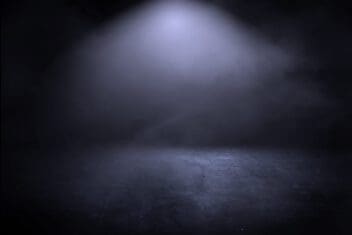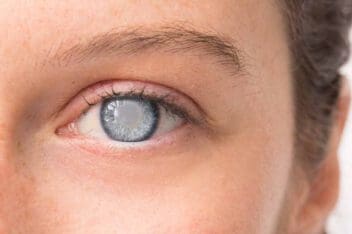Low Vision: What Does it Mean? (+ Examples)
Home / Eye Conditions & Eye Diseases /
Last Updated:
Table of Contents
Low vision involves not being able to see the world around you very well even with corrective devices like glasses or contact lenses.
There are different ranges of vision loss, often measured by refractive differences in visual acuity based on the Snellen chart. Loss of peripheral or central vision can lead to a diagnosis of low vision, as can spots of vision loss around the visual field.
There are several potential causes of low vision, from hereditary and congenital disorders to injury and infection.
As medical treatments and technology both improve, there are many devices that can be helpful for people with low vision. Low vision rehabilitation can help you use the vision you currently have to maximum potential.
What Does ‘Low Vision’ Mean?
When you have low vision, you are unable to find a way to correct your vision with contact lenses, glasses, medicine or surgery. It’s not the same as being blind because you will be able to see but only in a limited capacity.
If you have not been diagnosed with low vision, you may have it if you have difficulties reading, recognizing faces and telling colors apart.
Low vision can also present with blurry sight and blind spots.
Types of Low Vision
Low vision affects about 4 million Americans, and the international classification of disease categorizes it based on the visual capabilities of the better eye. For instance:
- Near normal vision or mild vision loss: between 20/30 and 20/60
- Moderate low vision: between 20/70 and 20/160
- Severe low vision: 20/200
- Profound vision loss: between 20/500 and 20/1000
- Total low vision: less than 20/1000
You deserve clear vision. We can help.
With 135+ locations and over 2.5 million procedures performed, our board-certified eye surgeons deliver results you can trust. Your journey to better vision starts here.
Most common types of low vision come with the following symptoms:
- Blurry vision
- Central vision loss
- Peripheral vision loss
- Night blindness
- Light sensitivity
- Loss of contrast sensitivity
Blurry Vision
This leads to hazy and out of focus objects, either near or far, regardless of eyeglasses used.
Central Vision Loss
This is when blind spots and blurry images appear in the central parts of your vision, but the side vision (peripheral vision) remains intact. Because peripheral vision remains unaffected, you will have no mobility issue. However, you’re likely to have problems reading, driving and recognizing faces and distant objects.
Peripheral Vision Loss
Known colloquially as “tunnel vision,” this condition means you can’t see what’s on one side or the other side from where are – or above or below, either. You can only see the object of your direct focus, your immediate line of sight.
Peripheral vision loss causes mobility difficulties and slow reading speeds.

Night Blindness
Night blindness means you can’t see in low-light areas, such as dimly lit interior rooms or outside at night.
Light Sensitivity
Light sensitivity occurs when an average light environment overwhelms you, creates glare or washes out images. In severe cases, you experience significant uncomfortableness or even pain amid light conditions that are routine or normal for others.
Loss of Contrast Sensitivity
Here you feel reduced vision quality and contrast sensitivity with a general haze and feeling of cloudiness.
How to Tell if You Have Low Vision (Signs & Symptoms)
The range of vision changes or vision loss includes:
- Mild vision loss: From 20/30 to 20/60 is a common range of poor eyesight for people who have myopia, presbyopia, hyperopia, and astigmatism. It is near-normal vision. When corrected vision measures in this range, it may be treated with a new eyeglass prescription.
- Moderate visual impairment: Ranging from 20/70 to 20/160, this is moderate low vision and may require additional forms of corrective wear or surgery to improve visual acuity.
- Severe visual impairment: Ranging from 20/200 or worse, this form of severe low vision is tough to treat and could lead to a diagnosis of legal blindness.
- No light perception. This is total blindness, or not being able to distinguish any objects or colors due to the inability to process light.
You may receive a diagnosis of low vision if:
- You lose best-corrected visual acuity (BCVA) in the dominant or clearer of your eyes to 20/70 or worse.
- You lose vision in your periphery or develop blind spots across your visual field.
- You meet the requirements for being legally blind.
It is important to know that visual acuity is the most common measurement of vision, but it is not the only form of vision change. Refractive errors, including nearsightedness and farsightedness, are the most common progressive eye disorders. Some conditions may allow someone to have 20/20 vision while also suffering vision loss that could lead to a diagnosis of low vision.
Other symptoms of low vision include:
- Trouble reading.
- Difficulty using computers or tablets.
- Discomfort watching TV.
- Trouble recognizing faces.
- Difficulty understanding switches or dials.
- Trouble with daily activities like driving or shopping.
- Trouble understanding how far away an object is (depth perception).
Potential Causes of Low Vision

While extreme refractive errors may be one of the most common causes, other causes of low vision include:
- Cataracts, which can cause hazy or blurry vision.
- Macular degeneration, which can partially obscure central vision.
- Diabetic retinopathy, which can cause blurriness, blind spots, and visual distortions.
- Glaucoma, which often involves progressive loss of peripheral vision.
- Retinitis pigmentosa, which also reduces peripheral vision, along with reducing low-light vision.
- Light sensitivity and loss of color or light contrast, which are symptoms of other conditions that can also make it hard to see.
- Eye injuries that may damage the cornea or retina.
- Hereditary conditions.
When children are born with low vision, this is typically a hereditary or congenital condition. While these can be managed, they are rarely curable.
Vision loss in older adults is common due to age-related eye conditions, like glaucoma, macular degeneration, and cataracts. These conditions have varying levels of treatment, from monitoring the disease’s progress and prescribing different glasses to prescription medications and eye drops to surgery.
Adults of working age, between 20 and 64 years old, may suffer vision loss due to injury or illness, including some genetic conditions. In some instances, the disease’s progress can be slowed, but vision loss means that an adult will have to learn to navigate the world in new ways, which may be traumatic and can cause significant grief. The ability to perform independent activities like reading books or driving can be greatly impacted by vision loss, and this may be difficult to accept.
Fortunately, there are technological improvements alongside medical advancements that are making life easier for people who struggle with low vision.
Diagnosing Low Vision
When eye doctors begin the diagnostic process for low vision, they follow a typical path of gathering your personal and family-related eye history and general health. They then shift to your ongoing visual difficulties and their impact on your daily activities, such as reading, driving, walking and facial recognition.
The process then moves to testing. Your ophthalmologist will perform a dilated eye exam and test your ability to tell the shapes and details of what you’re looking at (visual acuity) using low-vision test charts. The exam may also include tests for reading ability, contrast sensitivity and glare light sensitivity.
Next comes an individual rehabilitation plan based on your visual levels if you have low vision. Your doctor may also recommend testing for depression as it’s common among people with low vision.
You deserve clear vision. We can help.
With 135+ locations and over 2.5 million procedures performed, our board-certified eye surgeons deliver results you can trust. Your journey to better vision starts here.
Low Vision vs. Legal Blindness
Legal blindness occurs when your good eye has less than 20/200 vision or when you have a field of vision that’s less than 21 degrees at its widest point. That means you may have some useful vision even when you are legally blind.
Low vision refers to loss of visual acuity even with viewing aids such as contact lenses or glasses. It can affect your nearsightedness or farsightedness, although you will retain some functional vision.
You can treat sight disorders such as diabetic retinopathy. You can also deploy visual aids, such as:
- Reading prisms
- Hand magnifiers
- Telescopic glasses
- Magnifying glasses
- Lenses that filter light
If you struggle with routine tasks such as shopping and reading, the eye doctor may refer you to a vision rehabilitation team. On the other hand, you could opt for non-optical aids, such as:
- Video magnifiers
- Text reading software
- Large print publications
- Talking watches and clocks
- High contrast clocks and watches
- Electronic devices with enlarged numbers
You must have regular eye exams (preferably one a year) to catch any serious vision- or eye-related issues early enough to make a difference in your long-term eyesight and health.
Prevention
Only people who have diabetes can prevent low vision. You can prevent further vision loss by treating glaucoma and macular degeneration.
Financial Assistance
It’s not that well-known, but there are a number of ways you can get financial assistance to pay for treatment for your vision issues. One big program is the EyeCare America Program provided by the American Academy of Ophthalmology. It offers free services for:
- People 65 and older, providing eye exams and follow up care up to a year after
- A glaucoma eye exam for eligible people without insurance
If you have vision troubles that prevent you from working and you had worked long enough while paying social security, you may qualify for Social Security disability benefits.
You deserve clear vision. We can help.
With 135+ locations and over 2.5 million procedures performed, our board-certified eye surgeons deliver results you can trust. Your journey to better vision starts here.
References
- Low Vision. American Optometric Association (AOA).
- What Is Low Vision? (June 2017). All About Vision.
- Low Vision and Legal Blindness Terms and Descriptions. American Foundation for the Blind (AFB).
- Low Vision Symptoms. (February 25, 2019). American Academy of Ophthalmology (AAO).
- Low Vision Diagnosis and Treatment. (February 25, 2019). American Academy of Ophthalmology (AAO).
- Low Vision Rehabilitation Teams and Services. (February 25, 2019). American Academy of Ophthalmology (AAO).
- Low Vision Assistive Devices. (February 25, 2019). American Academy of Ophthalmology (AAO).
- Low Vision Diagnosis and Treatment. (September 2021). American Academy of Ophthalmology
- Low Vision Rehabilitation Teams and Services. (September 2021). American Academy of Ophthalmology
- How It Works. (Retrieved October 2021). American Academy of Ophthalmology
- Low Vision and Vision Rehabilitation. (Retrieved October 2021). American Optometric Association.
- If You’re Blind Or Have Low Vision — How We Can Help. (January 2021). Social Security Administration.
- Low Vision. (May 2020). National Eye Institute
- How are the terms low vision, visually impaired, and blind defined? (April 2021). University of Washington.
- Low Vision: What You Need to Know as You Age. (May 2020). Johns Hopkins Medicine.
This content is for informational purposes only. It may have been reviewed by a licensed physician, but is not intended to serve as a substitute for professional medical advice. Always consult your healthcare provider with any health concerns. For more, read our Privacy Policy and Editorial Policy.